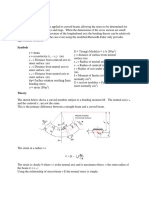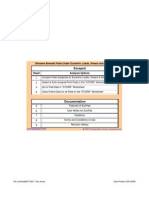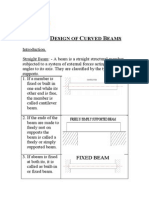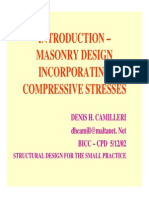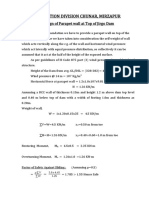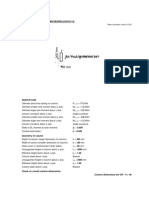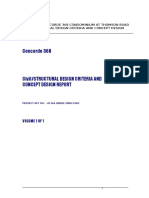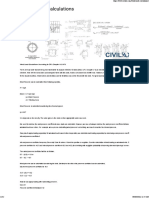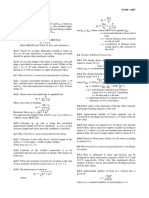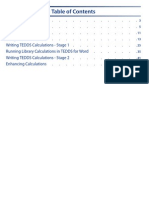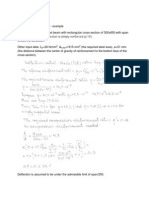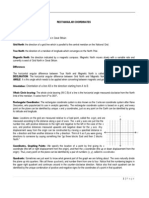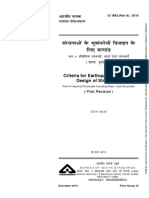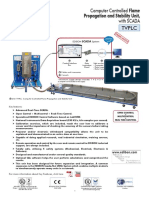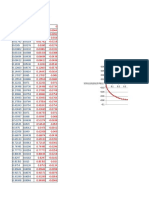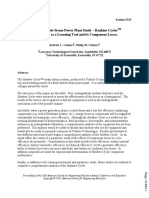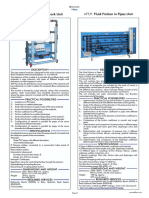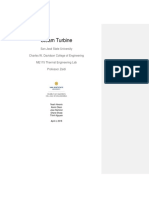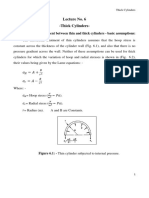0 ratings0% found this document useful (0 votes)
89 viewsLesson 32 Design of Curved Beams
Lesson 32 Design of Curved Beams
Uploaded by
vrajendraupadhyayCurved beams have a curved neutral axis rather than a straight one. The bending stress in a curved beam varies hyperbolically with distance from the neutral axis rather than linearly as in a straight beam. To analyze stress in a curved beam, assumptions are made about the radius of the outer fiber, inner fiber, centroidal axis, and neutral axis. The eccentricity between the centroidal and neutral axis can be calculated, and the bending stress in any fiber is given by a hyperbolic equation related to this eccentricity and distance from the neutral axis. Maximum stress occurs at the inner or outer fiber and must be checked for both symmetrical and unsymmetrical cross sections. References for further information are provided.
Copyright:
© All Rights Reserved
Available Formats
Download as DOCX, PDF, TXT or read online from Scribd
Lesson 32 Design of Curved Beams
Lesson 32 Design of Curved Beams
Uploaded by
vrajendraupadhyay0 ratings0% found this document useful (0 votes)
89 views4 pagesCurved beams have a curved neutral axis rather than a straight one. The bending stress in a curved beam varies hyperbolically with distance from the neutral axis rather than linearly as in a straight beam. To analyze stress in a curved beam, assumptions are made about the radius of the outer fiber, inner fiber, centroidal axis, and neutral axis. The eccentricity between the centroidal and neutral axis can be calculated, and the bending stress in any fiber is given by a hyperbolic equation related to this eccentricity and distance from the neutral axis. Maximum stress occurs at the inner or outer fiber and must be checked for both symmetrical and unsymmetrical cross sections. References for further information are provided.
Original Description:
Design for curved beam
Original Title
Curved Beam
Copyright
© © All Rights Reserved
Available Formats
DOCX, PDF, TXT or read online from Scribd
Share this document
Did you find this document useful?
Is this content inappropriate?
Curved beams have a curved neutral axis rather than a straight one. The bending stress in a curved beam varies hyperbolically with distance from the neutral axis rather than linearly as in a straight beam. To analyze stress in a curved beam, assumptions are made about the radius of the outer fiber, inner fiber, centroidal axis, and neutral axis. The eccentricity between the centroidal and neutral axis can be calculated, and the bending stress in any fiber is given by a hyperbolic equation related to this eccentricity and distance from the neutral axis. Maximum stress occurs at the inner or outer fiber and must be checked for both symmetrical and unsymmetrical cross sections. References for further information are provided.
Copyright:
© All Rights Reserved
Available Formats
Download as DOCX, PDF, TXT or read online from Scribd
Download as docx, pdf, or txt
0 ratings0% found this document useful (0 votes)
89 views4 pagesLesson 32 Design of Curved Beams
Lesson 32 Design of Curved Beams
Uploaded by
vrajendraupadhyayCurved beams have a curved neutral axis rather than a straight one. The bending stress in a curved beam varies hyperbolically with distance from the neutral axis rather than linearly as in a straight beam. To analyze stress in a curved beam, assumptions are made about the radius of the outer fiber, inner fiber, centroidal axis, and neutral axis. The eccentricity between the centroidal and neutral axis can be calculated, and the bending stress in any fiber is given by a hyperbolic equation related to this eccentricity and distance from the neutral axis. Maximum stress occurs at the inner or outer fiber and must be checked for both symmetrical and unsymmetrical cross sections. References for further information are provided.
Copyright:
© All Rights Reserved
Available Formats
Download as DOCX, PDF, TXT or read online from Scribd
Download as docx, pdf, or txt
You are on page 1of 4
At a glance
Powered by AI
The key takeaways are that the neutral axis and centroidal axis do not coincide in a curved beam, bending stress has a hyperbolic distribution, and expressions are given to calculate R and RN for standard cross-sections.
The neutral axis of a curved beam is shifted towards the centre of curvature, while the centroidal axis remains in the geometric centre. This causes an eccentricity between the two axes.
Bending stress in any fibre of a curved beam at a distance 'y' from the neutral axis is given by the equation σ = M*e/I*y, where stress has a hyperbolic distribution with respect to y.
LESSON 32 DESIGN OF CURVED BEAMS
32.1 Introduction
Beam having its neutral axis curved in unloaded condition is
known as curved beam. Neutral axis and centroidal axis of a
curved beam do not coincide. Neutral axis of curved beams is
shifted towards the centre of curvature. Also the bending stress
in case of curved beam, varies hyperbolically with the distance
from the neutral axis and variation is not linear as in case of
straight beams. Figure 32.1 shows distribution of stress in
curved beam.
Figure 32.1 Distribution of Stress in a Curved Beam
In stress analysis of curved beam, following assumptions are
made:
Let Ro = radius of outer fibre (mm)
R1 = radius of inner fibre (mm)
R = radius of centroidal axis (mm)
RN = radius of neutral axis (mm)
hi = distance of inner fibre from neutral axis (mm)
ho = distance of outer fibre from neutral axis (mm)
M = bending moment with respect to centroidal axis (N-mm)
A = area of the cross-section (mm2)
Eccentricity between centroidal and neutral axis is given by,
Bending stress in any fibre, at distance ‘y’ from the neutral axis,
is given by,
Equation indicates that stress has hyperbolic distribution with
respect to y. Maximum stress occurs either at the inner fibre or
at the outer fibre.
In symmetrical cross-sections (circular, rectangular etc.),
maximum bending stress always occurs at the inner fibre. But
for unsymmetrical sections, stress must be calculated for inner
and outer fibre to find its maximum value. Value of e is
generally very small but its precise calculation is very important
to avoid error in stress determination. Expressions for
calculation of R and RN, for some standard cross-sections are
given in table 32.1.
Table 32.1 R and RN for some Standard Cross-sections
References
1. Design of Machine Elements by VB Bhandari
2. Analysis and Design of Machine Elements by V.K. Jadon
3. Design of Machine Elements by C.S. Sharma & K. Purohit
4. Machine Design by P.C. Sharma & D.K. Aggarwal
5. Machine Design by R.S. Khurmi
You might also like
- Vortex Shedding FrequencyDocument38 pagesVortex Shedding FrequencyvrajendraupadhyayNo ratings yet
- Curved Beams 2Document5 pagesCurved Beams 2Robel MetikuNo ratings yet
- Escaped: Stresses Beneath Pads Under Eccentric Loads, Shears and MomentsDocument19 pagesEscaped: Stresses Beneath Pads Under Eccentric Loads, Shears and MomentsrowatersNo ratings yet
- Design of Curved Beams PDFDocument42 pagesDesign of Curved Beams PDFalibaba0110% (1)
- Chapter 2 - LIMIT STATE DESIGN OF SLAB 2Document60 pagesChapter 2 - LIMIT STATE DESIGN OF SLAB 2Yigezu YehombaworkNo ratings yet
- U4 l21 Numericals On Determination of True BearingDocument2 pagesU4 l21 Numericals On Determination of True Bearingzaidaan khanNo ratings yet
- The Best Ways To Calculate Wind Load - WikiHowDocument5 pagesThe Best Ways To Calculate Wind Load - WikiHowsreedharNo ratings yet
- Introduction Masonry Design DH CamilleriDocument13 pagesIntroduction Masonry Design DH CamilleriAdrian SpiteriNo ratings yet
- Tubular Profiles For Telecom Structures PDFDocument8 pagesTubular Profiles For Telecom Structures PDFJitendraNo ratings yet
- BS6399 3 1988Document31 pagesBS6399 3 1988Khaled Fada'aq100% (1)
- Irrigation Division Chunar, Mirzapur: Design of Parapet Wall at Top of Jirgo DamDocument4 pagesIrrigation Division Chunar, Mirzapur: Design of Parapet Wall at Top of Jirgo Damgovind narayan ShuklaNo ratings yet
- RC Rectangular Column DesignDocument6 pagesRC Rectangular Column DesignuqiNo ratings yet
- Bill Mosley John Bungey & Ray Hulse: Reinforced Concrete Design To EC2Document36 pagesBill Mosley John Bungey & Ray Hulse: Reinforced Concrete Design To EC2RyanWongJiaHanNo ratings yet
- Sample of Design BriefDocument17 pagesSample of Design BriefshingkeongNo ratings yet
- Preliminary Design of BRBF System: Use of Equivalent Lateral Force MethodDocument11 pagesPreliminary Design of BRBF System: Use of Equivalent Lateral Force MethodJacky TamNo ratings yet
- Materials Engineering: Pangasinan State University Urdaneta Campus Mechanical Engineering DepartmentDocument7 pagesMaterials Engineering: Pangasinan State University Urdaneta Campus Mechanical Engineering DepartmentiamjemahNo ratings yet
- Full Main 19M2 Reefed M Ain 15.5M2: PDF Created With Pdffactory Pro Trial VersionDocument1 pageFull Main 19M2 Reefed M Ain 15.5M2: PDF Created With Pdffactory Pro Trial VersionmarkomarkomarkomarkoNo ratings yet
- Wind Load CalculationDocument1 pageWind Load Calculationpapilolo2008No ratings yet
- Steady Flow in Pipes: BTB 323/ Cse 352 Hydraulics Edwin K. Kanda, PHDDocument19 pagesSteady Flow in Pipes: BTB 323/ Cse 352 Hydraulics Edwin K. Kanda, PHDErick WanduNo ratings yet
- 3 Pile Cap DesignDocument7 pages3 Pile Cap DesignSheikh Mizanur RahmanNo ratings yet
- Section 8 - Reinforced Concrete: B D S - S 2003Document58 pagesSection 8 - Reinforced Concrete: B D S - S 2003عصام السامرائيNo ratings yet
- Sheet Pile WallDocument11 pagesSheet Pile WallKhandaker Khairul AlamNo ratings yet
- Wind Load Calculations According To CP 3:chapter V-2:1972Document2 pagesWind Load Calculations According To CP 3:chapter V-2:1972Zain SaeedNo ratings yet
- Nota Design Using Ec2 2Document119 pagesNota Design Using Ec2 2mon100% (1)
- Design Spectrum According To Eurocode 8Document6 pagesDesign Spectrum According To Eurocode 8BN NGNo ratings yet
- Design of Steel and Timber StructuresDocument6 pagesDesign of Steel and Timber StructuresYi MokNo ratings yet
- Eurocode AdviceDocument1 pageEurocode Advicemassive85No ratings yet
- 116 Pavilion Road STS - 19 - CTMPDocument26 pages116 Pavilion Road STS - 19 - CTMPmarkomarkomarkomarkoNo ratings yet
- Analysis and Design of BeamsDocument12 pagesAnalysis and Design of BeamsHasanain AlmusawiNo ratings yet
- TEDDS Quick Start Guide (AS)Document48 pagesTEDDS Quick Start Guide (AS)Mu WeizhouNo ratings yet
- Calculation Deflection in Accordance To EC-2: 1.1 Design DataDocument15 pagesCalculation Deflection in Accordance To EC-2: 1.1 Design DataMisgun SamuelNo ratings yet
- Ib RCC StructuresDocument12 pagesIb RCC StructuresRaj BakhtaniNo ratings yet
- Advanced Structural AnalysisDocument9 pagesAdvanced Structural AnalysisYeswanth RaghavendraNo ratings yet
- 0 2 Reinforced Concrete Beam Design Procedure CompleteDocument4 pages0 2 Reinforced Concrete Beam Design Procedure CompleteRohana Illukkumbura100% (1)
- 8.SLS Crack and Deflection - ExampleDocument1 page8.SLS Crack and Deflection - ExampleAndreea CălinNo ratings yet
- Chapter 34Document9 pagesChapter 34Joey JohnsonNo ratings yet
- SurveyingDocument2 pagesSurveyingAsish Seeboo100% (1)
- Base PlateDocument8 pagesBase PlateIMJ JNo ratings yet
- Effect of Wind On Tall Building Frames - Impact of Aspect RatioDocument6 pagesEffect of Wind On Tall Building Frames - Impact of Aspect RatioRakkeshKudullaNo ratings yet
- ExportDocument36 pagesExportscegtsNo ratings yet
- Composite StructuresDocument25 pagesComposite StructuresVivek Premji100% (1)
- CCNY LabManualDocument29 pagesCCNY LabManualShady HegazyNo ratings yet
- Strip Footing ExampleDocument5 pagesStrip Footing ExampleBunkun15No ratings yet
- RCC13 Punching ShearDocument10 pagesRCC13 Punching ShearT Satheesh KumarNo ratings yet
- Combined Footing On PilesDocument13 pagesCombined Footing On PilesJohn GuerielNo ratings yet
- 1998 Bin-Bing Wang Cable-Strut Systems Part I TensegrityDocument9 pages1998 Bin-Bing Wang Cable-Strut Systems Part I TensegritynooraniaNo ratings yet
- 1893 Part4 2015Document31 pages1893 Part4 2015Aman GuptaNo ratings yet
- Wind Load Calculation: Project Artesia Mid Rise Building (G+28) On Plot No.676-5408 (E006) Subject Wind LoadDocument5 pagesWind Load Calculation: Project Artesia Mid Rise Building (G+28) On Plot No.676-5408 (E006) Subject Wind LoadAbdul BasithNo ratings yet
- M10-Install Prefabricated StairsDocument55 pagesM10-Install Prefabricated Stairsawel kedir100% (1)
- 3-Liquid Retaining StructuresDocument3 pages3-Liquid Retaining StructuresTabish IslamNo ratings yet
- Proceedings of The XV Conference of The Italian Association For Wind EngineeringDocument755 pagesProceedings of The XV Conference of The Italian Association For Wind EngineeringJoan DivesNo ratings yet
- A Catalogue of Details on Pre-Contract Schedules: Surgical Eye Centre of Excellence - KathFrom EverandA Catalogue of Details on Pre-Contract Schedules: Surgical Eye Centre of Excellence - KathNo ratings yet
- Design of Curved BeamsDocument5 pagesDesign of Curved BeamsNambiyanna Davanagere100% (1)
- Curved BeamsDocument16 pagesCurved Beamsmahendra babu mekalaNo ratings yet
- Unit 1Document8 pagesUnit 1harinathNo ratings yet
- Chapter 03 LeverDocument4 pagesChapter 03 Leverrajendra20No ratings yet
- Curved Beams EngineeringDocument85 pagesCurved Beams EngineeringpinkypachoNo ratings yet
- Lecture - Week 3 - StressesDocument36 pagesLecture - Week 3 - StressesAhmed MaherNo ratings yet
- 17ME64 DME-2 Module 1Document15 pages17ME64 DME-2 Module 1Venkatesh VenkiNo ratings yet
- 17me64 Dme-2 Module 1Document15 pages17me64 Dme-2 Module 1GgghhNo ratings yet
- AEE 334 Experiment #3: Flame Stability and Flame Speed ObjectiveDocument3 pagesAEE 334 Experiment #3: Flame Stability and Flame Speed ObjectivevrajendraupadhyayNo ratings yet
- Computer Controlled Flame Propagation EDIBONDocument13 pagesComputer Controlled Flame Propagation EDIBONvrajendraupadhyayNo ratings yet
- S1046 ProfileDocument4 pagesS1046 ProfilevrajendraupadhyayNo ratings yet
- ABB Micro Drives: ACS55, 0.18 To 2.2 KWDocument12 pagesABB Micro Drives: ACS55, 0.18 To 2.2 KWvrajendraupadhyayNo ratings yet
- FXLV 152 ProfileDocument8 pagesFXLV 152 ProfilevrajendraupadhyayNo ratings yet
- Co-Ordinates For Naca ProfilesDocument4 pagesCo-Ordinates For Naca ProfilesvrajendraupadhyayNo ratings yet
- Aerospace 04Document17 pagesAerospace 04vrajendraupadhyayNo ratings yet
- Valveless Pulsejet Engine ProjectDocument11 pagesValveless Pulsejet Engine ProjectvrajendraupadhyayNo ratings yet
- Univerity of West Indies Lab ReportDocument12 pagesUniverity of West Indies Lab ReportvrajendraupadhyayNo ratings yet
- Laboratory Scale Steam Power PlantDocument21 pagesLaboratory Scale Steam Power PlantvrajendraupadhyayNo ratings yet
- What Is A Planetary Gearbox?Document4 pagesWhat Is A Planetary Gearbox?vrajendraupadhyayNo ratings yet
- Basic Pipe Network Unit Fluid Friction in Pipes Unit: FME23. AFT/PDocument1 pageBasic Pipe Network Unit Fluid Friction in Pipes Unit: FME23. AFT/PvrajendraupadhyayNo ratings yet
- San Josh Univ Lab ReportDocument8 pagesSan Josh Univ Lab ReportvrajendraupadhyayNo ratings yet
- Thick Cylinder 1 PDFDocument13 pagesThick Cylinder 1 PDFvrajendraupadhyayNo ratings yet
- 1.1 What Is Design?: Lesson 1. Introduction To Machine DesignDocument8 pages1.1 What Is Design?: Lesson 1. Introduction To Machine DesignvrajendraupadhyayNo ratings yet
- Design of CouplingsDocument10 pagesDesign of CouplingsvrajendraupadhyayNo ratings yet
- Creep & Stress ConcenbtrationDocument6 pagesCreep & Stress ConcenbtrationvrajendraupadhyayNo ratings yet

